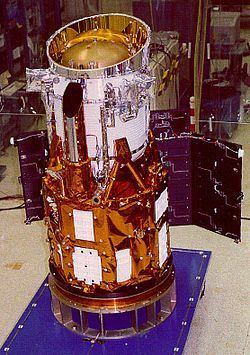Names Explorer-75, SMEX-5 COSPAR ID 1999-011A Launch date 5 March 1999 Inclination 97° Rocket Pegasus | SATCAT no. 25646 Inclination 97° Launch mass 250 kg Launch site Vandenberg Air Force Base | |
 | ||
Similar CHIPSat, Small Astronomy Satellite 2, Uhuru, Far Ultraviolet Spectrosc, Gamma | ||
The Wide Field Infrared Explorer (WIRE) was a satellite launched on March 5, 1999, on the Pegasus XL rocket into polar orbit between 409 and 426 km (254 and 265 mi) above the Earth's surface. WIRE was intended to be a four-month infrared survey of the entire sky at 21-27 micrometres and 9-15 micrometres, specifically focusing on starburst galaxies and luminous protogalaxies.
The science team was based at the Infrared Processing and Analysis Center in Pasadena, California. Flight operations, integration, and testing were from Goddard Space Flight Center in Maryland. The telescope was built by Space Dynamics Laboratories in Utah.
Premature ejection of the spacecraft aperture cover led to depletion of the solid hydrogen cryogen shortly after launch, ending the primary science mission. The onboard star tracker remained functional, and has been used for long-term precision photometric monitoring of bright stars in support of an asteroseismology program.
On May 10, 2011 (around 07:00 UTC), WIRE reentered Earth's atmosphere, according to the mission website.
Mission
A design flaw in the spacecraft control electronics caused the telescope dust cover to eject prematurely in its first few hours on-orbit, exposing the telescope to the Earth. In normal operations the telescope would avoid pointing at the Earth as well as the Sun because the heat load was too high for the cryogenic cooling. At this early stage in the mission, the telescope was deliberately pointed at the Earth for safety under the assumption that the dust cover was present. The influx of power into the telescope caused the solid hydrogen cryostat to boil off all of its cryogen. As a result, the cryostat vent, now expelling gas at rates orders of magnitude higher than designed, acted as a tiny thruster rocket overwhelming the attitude control system and ultimately spinning the spacecraft up as high as 60 rpm. After the hydrogen was exhausted, spacecraft engineers were able to re-establish attitude control. However, with the cryogen gone, the science instrument was no longer functional and the original science mission ended.
In order to salvage some functionality from the US$73 million spacecraft, operations were redirected after the failure of the cryogen system to an alternate science mission using the undamaged onboard star tracker for long-term monitoring of bright stars in support of an asteroseismology program. This technique aims to measure oscillations in nearby stars to probe their structure. While the star tracker has poor spatial resolution, having been designed primarily for a wide field of view and detection of the brightest stars, it is above the atmosphere and thus avoids scintillation, enabling high-precision photometry.
As a secondary experiment, one solar array includes a section with reflectors, to test a concentrator system.
The original science goals of WIRE may finally be achieved by the Wide-field Infrared Survey Explorer (WISE) mission which was successfully launched into orbit on December 14, 2009, and began observations on January 14, 2010.
